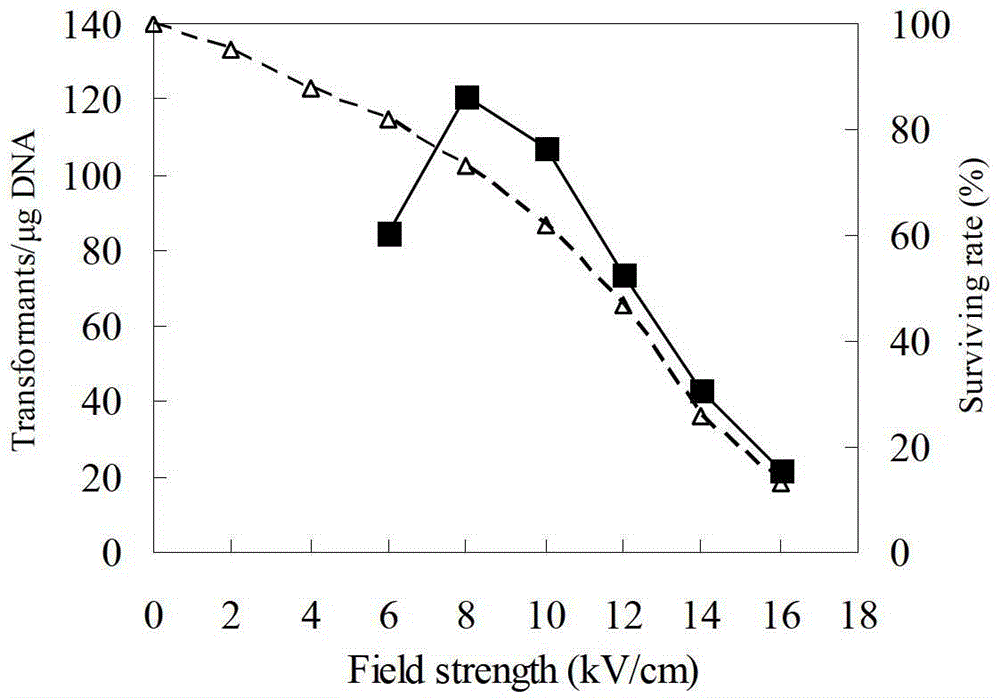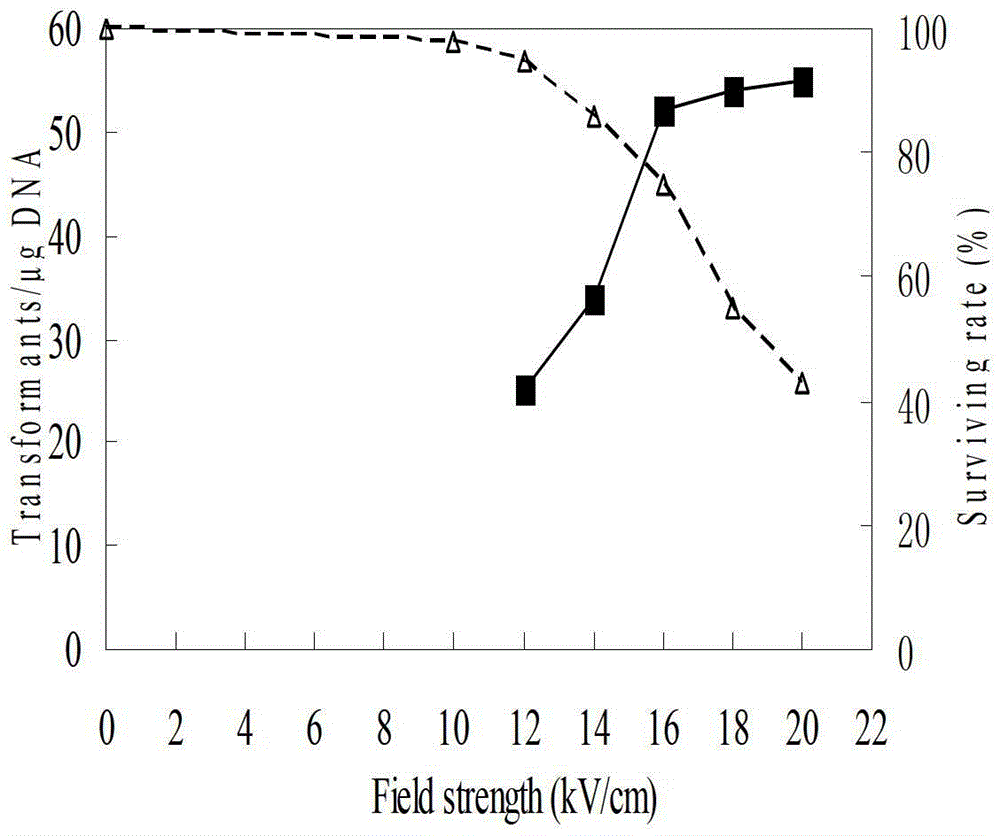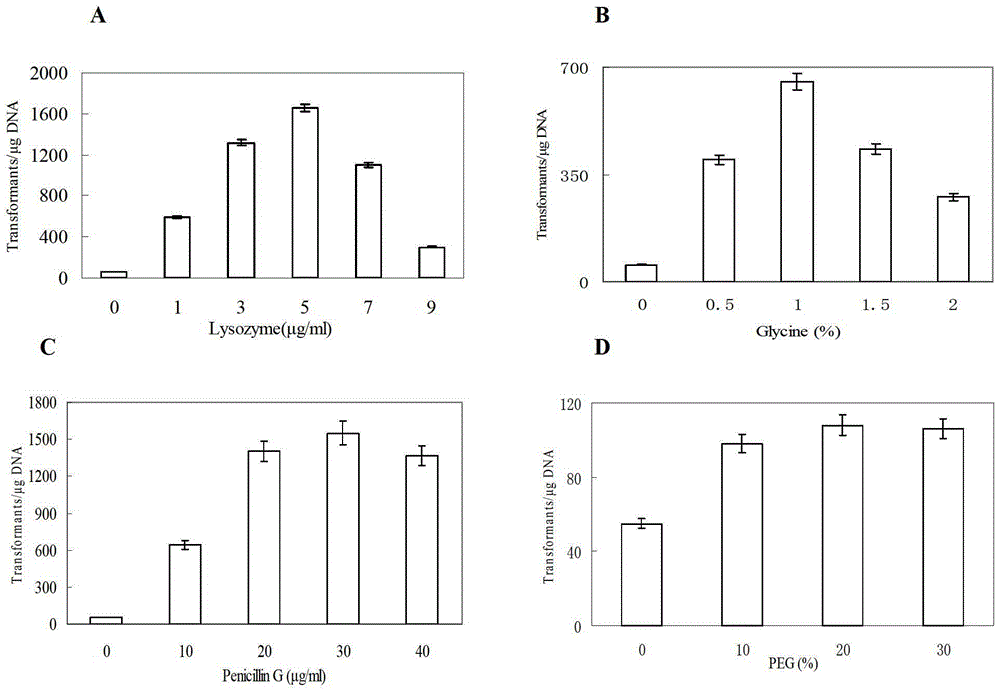Streptomyces diastatochromogenes electroporation transformation method
A technology of electric shock transformation and lysozyme, which is applied in the direction of using vectors to introduce foreign genetic material, recombinant DNA technology, etc., can solve the problems of low efficiency of transforming 1628 strains and no reports.
- Summary
- Abstract
- Description
- Claims
- Application Information
AI Technical Summary
Problems solved by technology
Method used
Image
Examples
Embodiment 1
[0028] Preparation of protoplasts and transformation by electric shock
[0029] Amylase Streptomyces chromogenes spores were transferred to a 250 ml shake flask containing 50 ml of CP medium, cultured at 28°C for two days, and 1.5 ml of the bacterial liquid was transferred to another fresh 250 ml flask containing 50 ml of CP medium In a shake flask, add 0.5% glycine, collect mycelia after 28-32 h, wash twice with 10% sucrose solution, resuspend the bacteria in lysozyme with a final concentration of 1 mg ml -1 5 ml of P buffer, reacted at room temperature for 1 h, and the obtained protoplasts were filtered with absorbent cotton, collected by centrifugation at 2000 rpm for 8 min, washed once with P buffer, and stored at -70°C for future use. 100 μl of protoplasts were mixed with an appropriate amount of plasmid DNA, placed on ice for 10 minutes, and then the mixture was placed in an electric shock cup, 1000 V (25 μF and 200Ω), diluted with P buffer and spread on the R2YE regene...
Embodiment 2
[0032] Electric Shock Transformation of Amylase Streptomyces Chromogenes Treated in Different Ways
[0033] Will S. diastatochromogenes 1628 was pre-cultured in CP medium for 28 hours, and then transferred to fresh CP medium for 1 day. Collect the cells by centrifugation (10,000 rpm, 10 min) at 4°C, and wash with 15 ml of pre-cooled 10% sucrose solution twice. Second-rate. Wash the cells twice with 15 ml pre-cooled 15% glycerol solution, then treat the cells with four different additives, and finally resuspend the competent cells in PGS buffer, so that the concentration of the cells is about 2×10 9 cells ml -1 . 100 μl of competent cells were mixed with an appropriate amount of plasmid DNA, placed on ice for 10 minutes, electric shock parameters were 1200 V (25 μF and 200Ω), and 1 ml of CP medium was quickly added after electric shock, and reacted for 1 hour at 28°C. Spread on R2YE regeneration medium containing antibiotics and culture at 28°C for 3-4 days.
[0034] In...
Embodiment 3
[0045] S. diastatochromogenes Table 3 shows the optimized results of various electroporation transformation conditions for different cell forms. Among them, the pre-treatment of the cells refers to collecting the cells when the complete cells grow to the mid-logarithmic growth stage, and adding 3 μg / ml lysozyme and 20 μg / ml penicillin together to the electroporation transformation buffer to react with the cells for a period of time After a period of time, it will be used as a material for electric shock transformation. Immediately after electroporation transformation, add 1 ml of YEME medium and react at 28°C for 2-3 hours, and then spread R2YE solid medium containing corresponding antibiotics.
[0046] table 3 S. diastatochromogenes Optimization of various electroporation transformation conditions for different cell formats
[0047]
PUM
 Login to View More
Login to View More Abstract
Description
Claims
Application Information
 Login to View More
Login to View More - R&D Engineer
- R&D Manager
- IP Professional
- Industry Leading Data Capabilities
- Powerful AI technology
- Patent DNA Extraction
Browse by: Latest US Patents, China's latest patents, Technical Efficacy Thesaurus, Application Domain, Technology Topic, Popular Technical Reports.
© 2024 PatSnap. All rights reserved.Legal|Privacy policy|Modern Slavery Act Transparency Statement|Sitemap|About US| Contact US: help@patsnap.com










